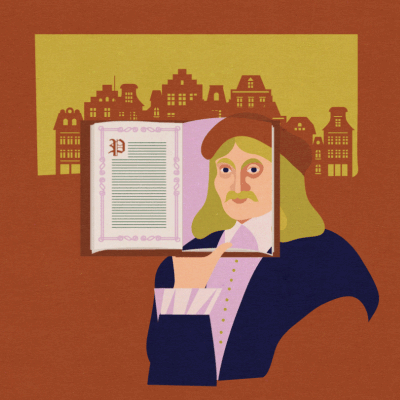Pranciškus Skorina – Lithuania’s First Publisher
> BACK TO 100 STORIESListen to this text (Lithuanian):
Pranciškus Skorina was born in 1490 in Polotsk, in what is now Belarus. He received an excellent education: he studied in Polotsk with the Bernardine Catholic monks, then studied in Krakow (Poland) and later at the University of Padua (Italy). In Padua he defended his doctorate in medicine and returned to Prague.
It was in Prague that he began his career as a publisher and printer. He was involved in the movement for writing in the mother tongue (Latin was the official language in the Middle Ages) and the Reformation movement, so he came up with the idea of publishing the Holy Scriptures in the Church Slavonic language. He even set up a printing house for this purpose. However, he didn’t stop at publishing the “Russian Bible” – he released a total of 23 publications.
Skorina moved to Vilnius in 1524 and established a printing house in what is now Vilnius Old Town. The restaurant Amatininkai [Eng. artisans], which has preserved the medieval interior, is now based where the Skorina’s printing house once stood. He published two books in the Church Slavonic language in Vilnius – The Little Travel Book (1522) and Apostol (‘The Apostle’, (1525)). These were the first books printed in Lithuania.
Both books are religious: The Little Travel Book consists of the most important religious texts – the psalter, akathists (Orthodox prayer-hymns), and a short religious calendar; Apostol contains texts from the New Testament. Unfortunately, due to unclear circumstances, Skorina soon had to stop his publishing activities. As if that was not enough, his home and printing house burned down during a fire in 1530. Tired of hardship, he returned to Prague where died in about 1541.
The books published by Skorina in Lithuania stand out for their excellent artistic design. The publisher himself wrote prefaces and commentaries for them using his knowledge of natural sciences, history, and geography. In addition, a portrait of Skorina is included in both books, which is unusual for both past and present times. Historians and researchers of early books state that the original introductions of Skorina's books and the publisher's portraits mark the beginning of the Renaissance era in the Grand Duchy of Lithuania.
Renaissance thinking is different from medieval thinking primarily because it focuses on the personality, merit and talent of the individual. In the Middle Ages, creators considered themselves to be instruments of God, so they didn’t even sign their writings and paintings. However, the Renaissance era draws attention to the author and to the individual in general. Therefore, Skorina no longer wanted to remain an anonymous publisher – he inserted his portrait and comments in the books he published.
Education became more highly regarded in the Renaissance era. In the Middle Ages, it was common even for rulers not to know how to read and write; it was enough for them to learn how to fight. Education was only needed by monks who copied and read the Bible, as well as working as scribes and translators for rulers and nobles. The growing importance of education for careers outside the church, such as in politics, led to an increased demand for books.
The Reformation was also connected to the Renaissance as it too stressed the need for education and personal relationship with God, which could be created through independent reading of the Bible. This required not only the ability to read, but also translations and new editions of the Bible in various languages. So, the need for translators, publishers and new printers increased.
The printer and publisher Skorina can be called the true man of the Renaissance. It is a pity that his activities in Vilnius came to an end soon. This is why the beginning of systematic publishing in the Grand Duchy of Lithuania dates to a later time and is associated with the printing house founded by the nobleman Mikalojus Radvila “the Black” in 1553.

